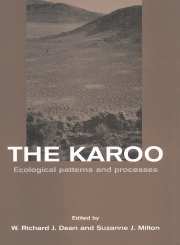Part three - Dynamics
Published online by Cambridge University Press: 23 December 2009
Summary
The study of rangeland dynamics has been orientated largely towards the important objective of preventing range degradation or desertification. This study has relatively recently entered an exciting phase. Confidence in the adequacy of conventional rangeland paradigms, which has prevailed for a long time, is progressively giving way to a succession of challenges from alternative theories. There is a growing conviction on the part of a number of range scientists, in southern Africa and elsewhere, that the conventional approach is not succeeding in its ultimate aim, and that it has not had a discernible positive effect on rangeland management (e.g. Hoffman, 1988b; Behnke and Scoones, 1993). It is therefore appropriate to start this overview with a brief introduction to the conventional ‘mainstream approach’, and its perceived shortcomings, before going on to the alternative paradigms.
Perhaps because of its complexity and relative lack of empirical data, the field of rangeland dynamics tends to be more strongly influenced than other disciplines by paradigms or models. One such model, appropriately termed the range succession model because of its roots in Clementsian succession theory (Westoby et al., 1989), has in the past largely dominated perceptions in range dynamics. This constitutes the conventional or ‘mainstream approach’ (Behnke and Scoones, 1993) of range scientists virtually throughout in the world. This model holds that communities are characterized by an equilibrium or climax state. Overgrazing causes the system to regress along a predictable pathway to earlier successional stages whereas a reduction in grazing pressure allows a return to the climax.
This model forms the basis of the widely applied botanically based system of range condition assessment.
- Type
- Chapter
- Information
- The KarooEcological Patterns and Processes, pp. 179 - 182Publisher: Cambridge University PressPrint publication year: 1999



